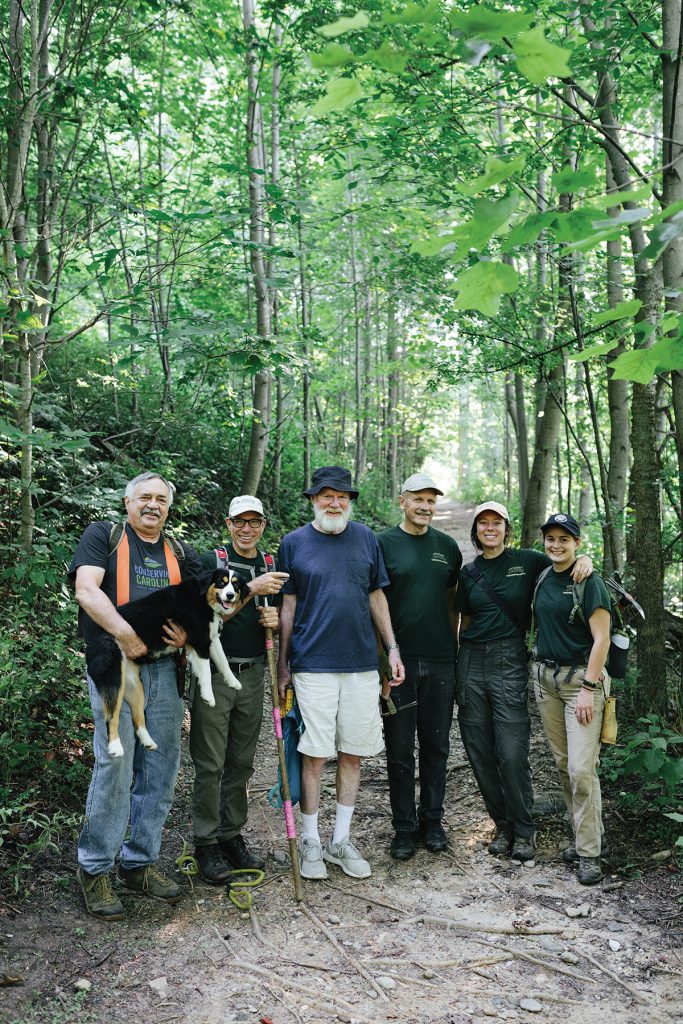The relentlessly methodical approach to eradicating a monster vine

IN THE WEEDS
(L-R) Greg Miner & Chloe, Don Dicey, Ed Marsh, Ford Smith, Laura Anderson, and Sarah Sussman attend to Norman Wilder Forest every Monday.
Photo by Rachel Pressley
Time and tide wait for no one, and neither does kudzu, aka “the vine that ate the South.” Folks joke that if you’re going to plant it, just drop it and run.
But please don’t. That idea was a colossal failure in the 1930s, when Southern farmers and the Civilian Conservation Corps copiously planted kudzu – which is native to Japan and China – in an attempt to reduce soil erosion. Nearly a century later, North America is still literally and figuratively reaping the unwanted results.
As Ford Smith attests, “Kudzu can spread a foot a day.” A board member of the nonprofit nature-conservation organization Conserving Carolina, based in Hendersonville, Smith is one of the original volunteers on the Kudzu Warriors team. Their mission is to rescue the 185-acre Norman Wilder Forest from the aggressively invasive vine.
But in its defense, kudzu isn’t all toil and trouble.

ROOT OF THE MATTER
Getting rid of kudzu involves laborious excavation of the “knuckle” joining the vine and taproot.
Photo by Rachel Pressley
Japanese cooks use it to make delicate desserts and comforting porridge. For thousands of years, it has played a central role in Chinese medicine, treating everything from heart inflammation to alcoholism. Without ubiquitous kudzu, Southern Gothic literature might suffer from metaphorical anemia, deprived of its mysterious backdrop that shines brightly during the day — only to emerge with secret, smothering ghastliness after dark. Cows, goats, and sheep graze for free on kudzu, and the shy purple flowers that hide behind the leaves in late summer smell like oh-so-Southern Nehi grape soda.
One of the earliest known uses of kudzu in the United States was as a shade plant, grown on porches in the South, where it provided sweet relief. The sprawling green leaves block out so much sunlight, in fact, that they kill any vegetation beneath their canopy. Left to their own devices, the vines can become so heavy that they break tree limbs while slowly strangling trees to death. Fortunately, the Kudzu Warriors are there to push back against the darkness and bring beloved native species back into the living light.

Greg Miner and Ford Smith swathed in kudzu.
Photo by Rachel Pressley
Kudzu Warriors was formed 10 years ago, recalls Smith, when Pam Torlina, a staff member at Conserving Carolina, named the effort in honor of Little Warrior Mountain (where Wilder Forest resides) and began to recruit volunteers. Greg Miner, who leads the crew, was one of the first to join — as was Smith. But this isn’t Smith’s first environmental-rescue rodeo. In 2015, he began to plant Restoration Chestnut trees in the forest, to replace those wiped out by the blight that devastated the original American Chestnut that once thrived in WNC. “Kudzu Warriors is a commitment like planting trees,” he says, acknowledging that “you won’t see all the results in your lifetime. But you do it because you think it will be better for next generation, and for the environment.”

Sarah Sussman digs deep for a kudzu crown.
Photo by Rachel Pressley
Despite the stubbornness of the vine, the Kudzu Warriors have enjoyed visible, sustainable progress as a reward for their persistence. “From just doing maintenance,” Smith reports, “you see native wildflowers like bloodroot or Mayapple pop up out of the ground that you didn’t know were there. But complete eradication goes slowly. In 10 years, we have probably freed seven or eight acres.”

Chloe, the K9 Kudzu Warrior, takes a rest.
Photo by Rachel Pressley
Most of the work involves digging to the crown or “knuckle” between the vine and the taproot, where its growth originates. “You have to get under the crown to sever it from the root,” explains Smith. In rocky soil the crown may be close to the surface and easy to reach. But in dry soil or clay, it’s a challenge. “You may also have 50 crowns in a 3-square-foot area and big, heavy crowns that are hard to remove. The crown sends out multiple tap roots and you have to cut them away and completely remove the crown or it will grow back. Everyone has their favorite tool. I use one that has a heavy mallet on one side and a sharp point on the other. Greg uses a battery-operated saw.”
The vine has no domestic enemies, despite decades of attempts by research scientists to figure out why it’s controllable in Asia but not here. That relegates the Kudzu Warriors to the last line of defense for a vulnerable, valuable forest. They soldier on to tame the creeper that never sleeps, getting after it every Monday of the year unless the weather is extreme.

A kudzu plant up close.
Photo by Rachel Pressley
But Smith says it’s not a chore, because the team intentionally makes it fun. “Usually there are five to seven volunteers, and we have a couple of great people from AmeriCorps who help. It’s actually kind of Zen work, and we enjoy the camaraderie.”
Norman Wilder Forest, U.S. Hwy. 176, Tryon. Conserving Carolina, 847 Case St., Hendersonville. For more information about The Kudzu Warriors, including volunteering opportunities, call 828-697-5777 or visit Conserving Carolina’s website: conservingcarolina.org/kudzu-warriors



